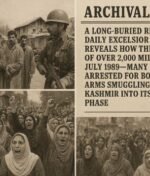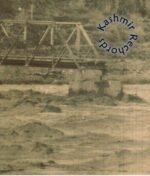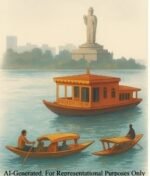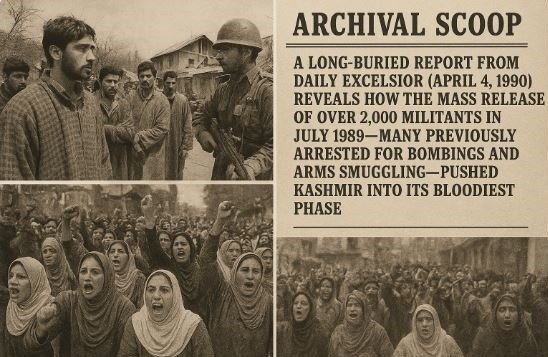
When 2,000 Kashmiri Militants Were Set Free in July 1989!
A startling disclosure reveals how political leniency undid years of security efforts and unleashed a cycle of violence that still haunts the Valley.
(Kashmir Rechords Exclusive)
Long before Kashmir was consumed by the insurgency of the 1990s, security agencies had spent decades apprehending extremists, smugglers of arms and subversive elements. Yet, in a twist of fate that would haunt the Valley for decades, political leniency undid years of counter-insurgency work—triggering a full-blown rebellion and a humanitarian tragedy that still casts its shadow.
While the “rigged” 1987 elections are often cited as the tipping point for militancy, an equally explosive and lesser-known episode was the mass release of over 2,000 detainees in July 1989. These were not petty offenders—they had been arrested for bomb blasts, arms smuggling and anti-national conspiracies, many booked under the stringent Terrorist and Disruptive Activities (Prevention) Act (TADA). Yet, they walked free.
The Report That Warned of Disaster
A rare report from Daily Excelsior, dated April 4, 1990, by senior journalist Sanjeev Pargal, exposed this startling decision and its dire consequences. Quoting official sources, the report revealed that from 1965 to 1989, over 2,000 individuals were arrested for subversive acts—but not a single prosecution reached its logical end. Kashmir Rechords is exclusively reproducing the newspaper cutting of the published news item.
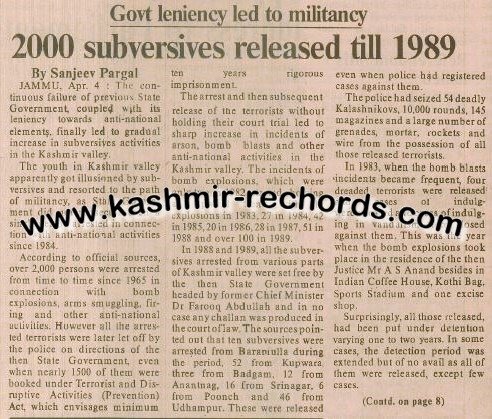
Rising Explosions – A Timeline of Neglect
- 1982 – Two bomb blasts reported.
- 1983 – 15 explosions.
- 1984 – 27 explosions.
- 1985 – 42 explosions.
- 1986 – 20 explosions.
- 1987 – 28 explosions.
- 1988 – 51 explosions.
- 1989 – Over 100 blasts rocked the Valley.
This escalating graph of violence mirrored a disturbing trend—soft-pedalling militancy instead of tightening the noose.
Weapons Seized, Yet Militants Walked Free
Perhaps the most shocking detail in the report was the cache of weapons recovered from those later released:
- 54 Kalashnikov rifles
- 10,000 rounds of ammunition
- 145 magazines
- Grenades, mortars, and even rockets
Despite such incriminating evidence, trials were abandoned, and charges dropped. In some cases, even after high-profile bombings—such as those at Justice A.S. Anand’s residence and Indian Coffee House, Kothi Bagh, attack on Excise Shop—dreaded militants were set free.
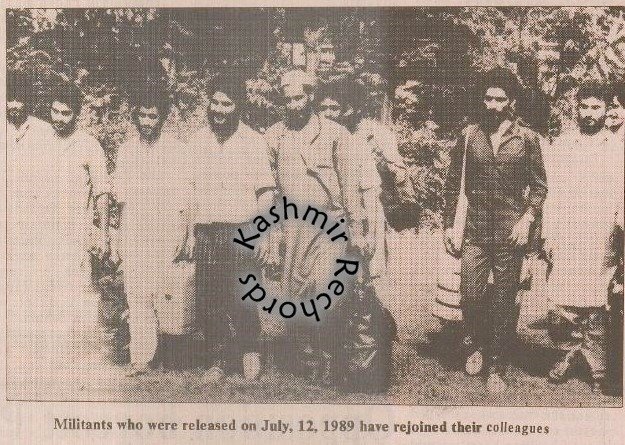
The Human Cost – Exodus and Bloodshed
Many of the freed detainees resurfaced as active members of armed outfits that later unleashed terror on an unimaginable scale. The tragic chain of events culminated in the targeted killings of innocents and mass exodus of Kashmiri Pandits in early 1990—a wound that continues to ache in the collective memory of the community.
A Question That Haunts
While the present J&K Union Territory administration has reopened several cold-blooded killing cases of the 1990s, one question remains:
Will there be a probe into the decision that set militants free in 1989?
Who authorised this unprecedented amnesty? What political compulsions led to such a move? And can accountability still be fixed for one of the gravest missteps in Kashmir’s modern history?
More than three decades later, the mass release of July 1989 remains an overlooked chapter in Kashmir’s troubled narrative—one that deserves national attention, not just for its historical value, but for the lessons it carries about policy, security and the cost of political expediency.

